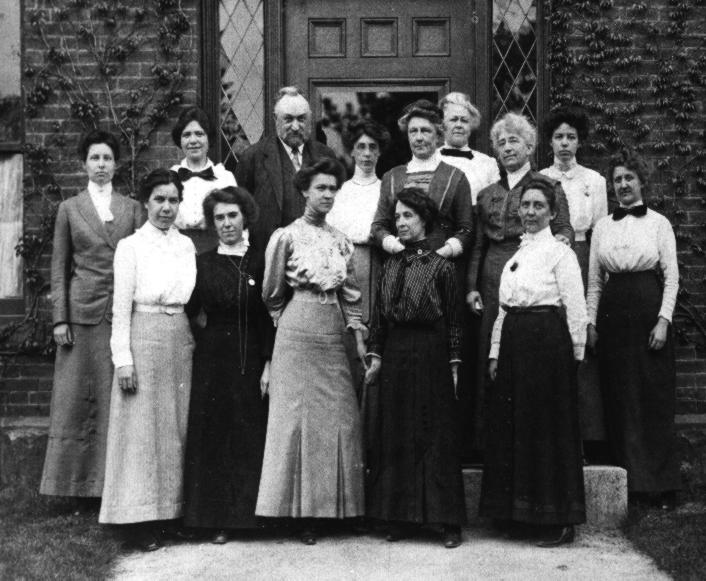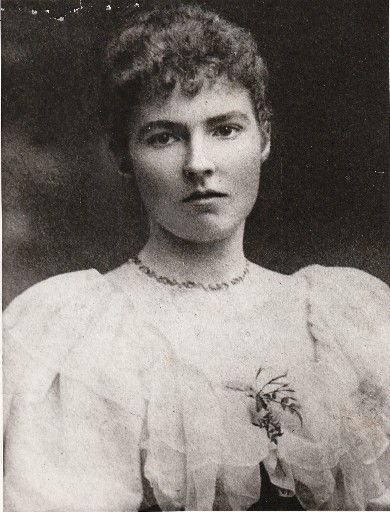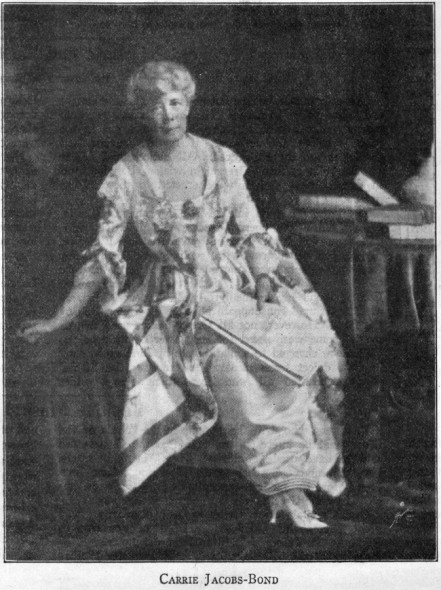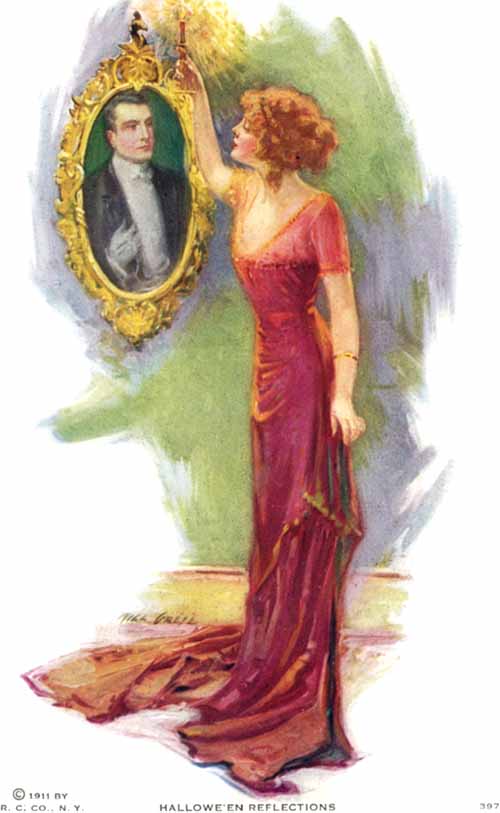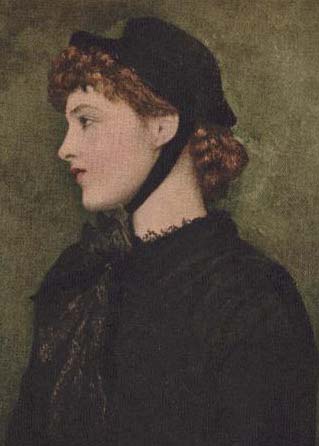 Hairstyles of this period shifted with the shifting silhouette in dress and also reflected, as the era progressed, the growing freedom and emphasis on ease in hairdressing that marked a more mobile society. The agricultural depression of the 1880s which dampened spirits, expressed itself in the somber, less frivolous clothing of the decade. This was the height of the bustle era, but somehow they didn’t seem as jaunty or frivolous as they appeared in the 1870s. This bustle was formidable and wowing in its height and width, as though ladies were adamant against being blindsided from behind. Accordingly, men’s clothing became unerringly correct and, despite the aberration that was the Aesthetic movement, dark colors, close-tailored and stout fabrics were the norm. To accompany this fashionable armor, ladies’ hair was worn close to the head and rolled tightly at the crown, with small curls at the nape of the neck and light bangs (or “fringes” as they were called in England). Hardly any man of this period were clean-shaven and their hair was clipped short and shaggy.
Hairstyles of this period shifted with the shifting silhouette in dress and also reflected, as the era progressed, the growing freedom and emphasis on ease in hairdressing that marked a more mobile society. The agricultural depression of the 1880s which dampened spirits, expressed itself in the somber, less frivolous clothing of the decade. This was the height of the bustle era, but somehow they didn’t seem as jaunty or frivolous as they appeared in the 1870s. This bustle was formidable and wowing in its height and width, as though ladies were adamant against being blindsided from behind. Accordingly, men’s clothing became unerringly correct and, despite the aberration that was the Aesthetic movement, dark colors, close-tailored and stout fabrics were the norm. To accompany this fashionable armor, ladies’ hair was worn close to the head and rolled tightly at the crown, with small curls at the nape of the neck and light bangs (or “fringes” as they were called in England). Hardly any man of this period were clean-shaven and their hair was clipped short and shaggy.
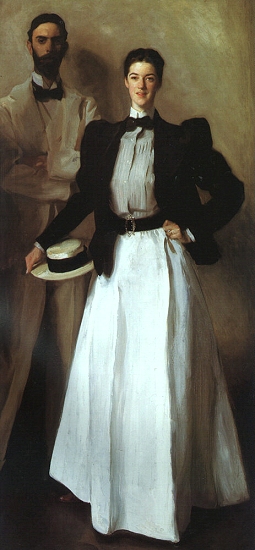 The early 1890s saw a slight loosening of the hair, and as this decade progressed, ladies’ hair softened and ballooned nearly as drastically as their sleeves! Fringes remained, though with the slight pompadour effect, the height required need as much hair as a woman had on her head–and then some. Ever since the simple coiffures of the first two decades of the 19th century disappeared, ads filled newspapers selling all manners of fake hair. Ladies brushed their hair daily not only for cleanliness but to collect enough hair in the bristles to make their own “rats” and “pads” to bulk up their thin locks. The sale of hair became big business (hence the scene in Little Women) and to save even more time, hair companies created styled hairpieces–braided coils, ponytails, even whole wigs! No longer was it shameful for a woman to lack her own head of plentiful, glossy hair: she could buy it.
The early 1890s saw a slight loosening of the hair, and as this decade progressed, ladies’ hair softened and ballooned nearly as drastically as their sleeves! Fringes remained, though with the slight pompadour effect, the height required need as much hair as a woman had on her head–and then some. Ever since the simple coiffures of the first two decades of the 19th century disappeared, ads filled newspapers selling all manners of fake hair. Ladies brushed their hair daily not only for cleanliness but to collect enough hair in the bristles to make their own “rats” and “pads” to bulk up their thin locks. The sale of hair became big business (hence the scene in Little Women) and to save even more time, hair companies created styled hairpieces–braided coils, ponytails, even whole wigs! No longer was it shameful for a woman to lack her own head of plentiful, glossy hair: she could buy it.
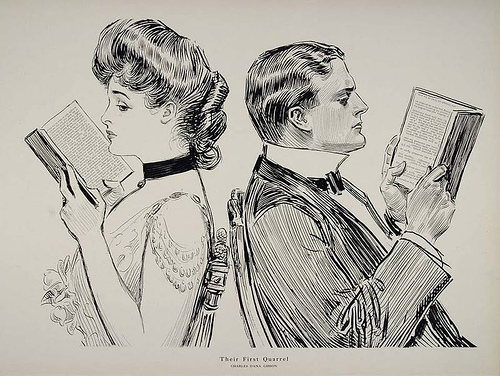 The 1900s were apogee of false hair. The full-blown pompadour look was in fashion, mostly inspired by Charles Dana Gibson’s iconic Gibson Girl. The sketches showed a beautiful woman with high and full up-do, and women rushed to emulate this with any manner of rats, pads and hair pieces. The Gibson Man–square-jawed, broad-shouldered, athletic, and more important, clean-shaven–inspired a new generation of young men as well. Beards had fallen out of favor and though mustaches retained their supremacy (particularly in the military, where officers were required to sport one), a lack of facial hair signified youthfulness and vigor, which matched the cavalier and derring-do spirit of the age. The latter part of the first century saw a widening of hats and a widening of hair to carry the wide-brimmed “Merry Widow”. However, the hair lost a bit of its height and was generally parted on the side or in the middle, and was fluffed low and wide towards the ears and nape.
The 1900s were apogee of false hair. The full-blown pompadour look was in fashion, mostly inspired by Charles Dana Gibson’s iconic Gibson Girl. The sketches showed a beautiful woman with high and full up-do, and women rushed to emulate this with any manner of rats, pads and hair pieces. The Gibson Man–square-jawed, broad-shouldered, athletic, and more important, clean-shaven–inspired a new generation of young men as well. Beards had fallen out of favor and though mustaches retained their supremacy (particularly in the military, where officers were required to sport one), a lack of facial hair signified youthfulness and vigor, which matched the cavalier and derring-do spirit of the age. The latter part of the first century saw a widening of hats and a widening of hair to carry the wide-brimmed “Merry Widow”. However, the hair lost a bit of its height and was generally parted on the side or in the middle, and was fluffed low and wide towards the ears and nape.
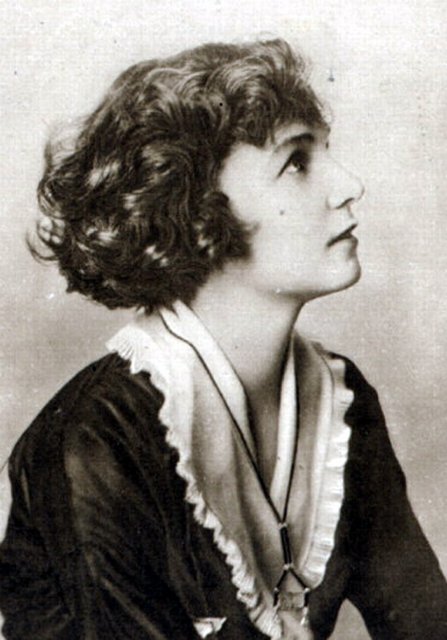 The 1910s saw a near abandonment of facial hair for young men. Their hair was now loose and tousled, no longer trapped by the macassar oil and brilliantine pomade of former years. For ladies, the slimming silhouettes needed slimmer hair, but rather than a retread of the 1880s, their hair was dressed so that it appeared ear-length and curled–almost bob-like beneath their close-fitting hats. In fact, some women even went so far as to bob their hair, mostly inspired by Irene Castle who chopped her locks in 1914 before a scheduled surgery (she didn’t want to deal with caring for long hair during her convalescence). This inspired a craze for the “Castle Bob” and when Irene added a necklace around her head, the “Castle band” took off as well. The craze for bobs during the war years actually preceded the Golden or Roaring Twenties, and ironically (or not), ladies’ hair of the immediate post-war years made an attempt to recapture the twilight of the Edwardian era with a short-lived favoring of a slight pompadour. But the tide of fashion is unstoppable in progress, and the new generation threw themselves headlong into embracing hairstyles the older considered horrid and masculine, altogether forgetting the horror that met their generation’s shift in coiffure.
The 1910s saw a near abandonment of facial hair for young men. Their hair was now loose and tousled, no longer trapped by the macassar oil and brilliantine pomade of former years. For ladies, the slimming silhouettes needed slimmer hair, but rather than a retread of the 1880s, their hair was dressed so that it appeared ear-length and curled–almost bob-like beneath their close-fitting hats. In fact, some women even went so far as to bob their hair, mostly inspired by Irene Castle who chopped her locks in 1914 before a scheduled surgery (she didn’t want to deal with caring for long hair during her convalescence). This inspired a craze for the “Castle Bob” and when Irene added a necklace around her head, the “Castle band” took off as well. The craze for bobs during the war years actually preceded the Golden or Roaring Twenties, and ironically (or not), ladies’ hair of the immediate post-war years made an attempt to recapture the twilight of the Edwardian era with a short-lived favoring of a slight pompadour. But the tide of fashion is unstoppable in progress, and the new generation threw themselves headlong into embracing hairstyles the older considered horrid and masculine, altogether forgetting the horror that met their generation’s shift in coiffure.
Further Reading:
Encyclopedia of Hair by Victoria Sherrow
One Thousand Beards: A Cultural History of Facial Hair by Allan Peterkin
The History of Hair: Fashion and Fantasy Down the Ages by Robin Bryer
1911 Hairstyles from the Girls’ Own Paper and Woman’s Magazine

